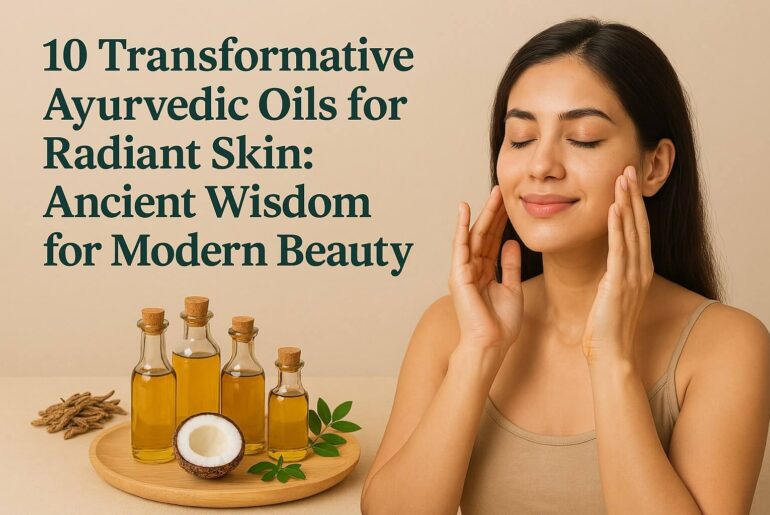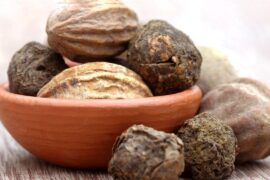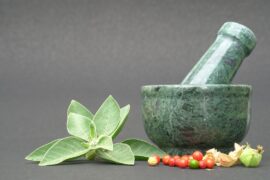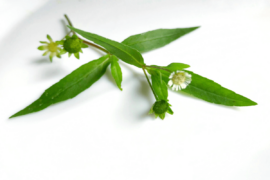Are you tired of cycling through endless skincare products that promise the world but deliver disappointment? You’re not alone. In my exploration of natural beauty solutions, I’ve discovered that Ayurvedic oils for skin offer something truly different – treatments backed by thousands of years of traditional wisdom that actually deliver visible results.
Ayurvedic skincare isn’t just about applying natural ingredients to your face; it’s a holistic approach that addresses your unique skin profile by balancing your body’s natural energies or doshas. These time-tested oils can transform dull, problematic skin into a radiant, healthy complexion without harsh chemicals or synthetic additives.
The global Ayurveda market was estimated at USD 14.4 billion in 2023 and is projected to grow at an impressive CAGR of 27.2% from 2024 to 2030. Why such explosive growth? Because more people are discovering what ancient civilizations knew all along – nature provides everything we need for beautiful, healthy skin.
In this comprehensive guide, I’ll walk you through the most effective Ayurvedic oils for skin that can help you achieve the glowing complexion you’ve always wanted. Whether you’re dealing with dryness, sensitivity, signs of aging, or simply want to enhance your skin’s natural radiance, these oils will put you on the path to holistic beauty.
Understanding Skin Health Through Ayurveda
Before diving into specific oils, it’s essential to understand how Ayurveda views skin health. According to this ancient system, your skin’s condition directly reflects your internal well-being and dosha balance.
How Doshas Affect Your Skin
In Ayurveda, everything is composed of the five elements – space, air, fire, water, and earth – which combine to form three doshas: Vata, Pitta, and Kapha. Your dominant dosha determines your skin’s natural characteristics:
Vata Skin (Air + Space):
- Naturally thin, dry, and cool to the touch
- Prone to fine lines, flaking, and roughness
- May appear dull or grayish when imbalanced
- Easily affected by environmental changes
- When imbalanced: excessive dryness, premature wrinkles, and uneven texture
Pitta Skin (Fire + Water):
- Medium thickness with warm undertones
- Tends to be sensitive and prone to redness
- Susceptible to inflammation and breakouts
- May develop freckles, moles, or reddish complexion
- When imbalanced: acne, rosacea, rashes, and hyperpigmentation
Kapha Skin (Water + Earth):
- Thick, oily, cool, and pale
- Smooth texture with good hydration
- Prone to enlarged pores and congestion
- Ages slowly with minimal wrinkles
- When imbalanced: excessive oiliness, cystic acne, water retention, and dullness
Understanding your skin’s dosha type is the first step toward selecting the right Ayurvedic oils. Is your skin naturally dry and prone to fine lines? You likely have Vata-dominant skin. Is it sensitive with a tendency to redden? That sounds like Pitta imbalance. Oily with persistent congestion? That’s classic Kapha.
Root Benefits of Ayurvedic Oils for Skin
Ayurveda looks beyond symptoms to address underlying causes. As Dr. Vasant Lad, renowned Ayurvedic physician, explains: “In Ayurveda, oils are not just for external application. The oil carries the healing properties of herbs deep into the tissues, delivering nutrition and therapeutic benefits where they’re needed most.”
The key benefits of Ayurvedic oils for skin include:
Moisturizing and Nourishing Properties: Ayurvedic oils penetrate deeply into skin layers, providing lasting hydration and essential nutrients that commercial moisturizers often can’t match.
Anti-inflammatory and Healing Effects: Many Ayurvedic oils contain natural compounds that calm irritation, reduce redness, and support the skin’s healing processes.
Balancing and Harmonizing Actions: Beyond addressing symptoms, these oils work to restore your skin’s natural balance based on your dosha type.
Anti-aging and Rejuvenating Qualities: Loaded with antioxidants and regenerative compounds, Ayurvedic oils combat free radical damage and promote cellular renewal.
By choosing oils appropriate for your dosha and specific skin concerns, you’ll create the ideal conditions for a naturally radiant complexion from the inside out.
10 Transformative Ayurvedic Oils for Skin Care
Now that we understand the Ayurvedic approach to skin health, let’s explore the most effective oils for promoting radiant, balanced skin.
Kumkumadi Tailam: The Royal Elixir
Known as the “miracle elixir” in Ayurveda, Kumkumadi Tailam is a luxurious formulation traditionally reserved for royalty. This precious oil lives up to its royal heritage with remarkable skin-transforming properties.
Ancient origins and formulation: Kumkumadi Tailam’s recipe appears in classical Ayurvedic texts dating back thousands of years. The authentic formulation contains up to 26 precious herbs and ingredients, with saffron (Kumkuma) as the star component.
Key ingredients:
- Saffron: Brightens complexion and reduces hyperpigmentation
- Sandalwood: Soothes inflammation and evens skin tone
- Indian Madder (Manjistha): Purifies blood and improves circulation
- Lotus pollen: Rejuvenates and hydrates the skin
- Sesame oil base: Carries the herbs deep into skin tissues
Benefits for skin:
- Brightens dull complexion
- Reduces dark spots, blemishes, and hyperpigmentation
- Minimizes fine lines and improves skin elasticity
- Balances skin tone and texture
- Provides deep hydration without greasiness
According to clinical studies at Blue Nectar, “100% of respondents felt brighter skin, 97% experienced reduced wrinkles, and 97% noticed reduced dark spots on their face” after regular use of Kumkumadi oil. It’s no wonder this formulation was awarded “Best Face Oil” by VOGUE magazine.
How to use Kumkumadi Tailam: Apply 2-3 drops to cleansed skin before bedtime. Gently massage in upward circular motions until fully absorbed. For enhanced benefits, perform this ritual consistently for at least 30 days.
Coconut Oil: Cooling and Soothing
This versatile oil is a staple in Ayurvedic skincare, particularly beneficial for Pitta-dominant skin types and conditions.
Ayurvedic properties: In Ayurveda, coconut oil is considered cooling, sweet, and heavy – making it perfect for balancing the hot, sharp qualities of Pitta dosha. It’s also suitable for certain Vata conditions but may be too heavy for Kapha imbalances.
Benefits for skin:
- Deeply moisturizes without clogging pores
- Creates a protective barrier against environmental damage
- Contains antimicrobial properties that help combat minor infections
- Rich in medium-chain fatty acids that strengthen the skin barrier
- Soothes inflammatory skin conditions like eczema and psoriasis
A 2019 study published in the International Journal of Molecular Sciences confirmed coconut oil’s significant anti-inflammatory and skin barrier repair effects. Researchers noted its ability to increase skin hydration and reduce water loss through the epidermis.
Best application methods: For face: Apply a small amount to damp skin after cleansing. For body: Warm the oil slightly before massaging into skin after bathing. For scalp treatments: Apply warm coconut oil to the scalp, leave for 30 minutes, then shampoo.
Who should avoid: Those with Kapha imbalances or very oily, congested skin should use coconut oil sparingly or choose a lighter alternative.
Sesame Oil: The Queen of Oils
Referred to as the “queen of oils” in Ayurveda, sesame oil (Til Tailam) is prized for its warming, nourishing, and penetrating qualities.
Warming properties: Sesame oil has a naturally warming effect, making it ideal for balancing Vata’s cold, dry nature. Its warming quality helps improve circulation and bring nutrients to the skin’s surface.
Benefits for skin barrier:
- Contains high levels of linoleic acid that strengthens the skin barrier
- Rich in antioxidants that combat environmental damage
- Naturally antibacterial and anti-inflammatory
- Deep penetration into all seven layers of skin
- Provides subtle sun protection (low SPF)
A comprehensive 2018 review in the International Journal of Molecular Sciences highlighted sesame oil’s significant anti-inflammatory properties and ability to promote skin barrier repair – particularly important for aging and damaged skin.
Best uses for different skin types: While especially beneficial for Vata skin, sesame oil can be used by all doshas when properly prepared. For Pitta and Kapha types, it’s best mixed with cooling oils or used in smaller amounts.
Traditional preparation: Authentic Ayurvedic preparation involves curing the oil by heating it to reduce its strong aroma and enhance its therapeutic properties.
Almond Oil: Nourishing and Balancing
Sweet almond oil strikes the perfect balance of being lightweight yet deeply nourishing, making it one of the most versatile Ayurvedic skin oils.
Dosha-balancing properties: Almond oil has an adaptable nature that benefits all doshas when used appropriately. It’s especially balancing for Vata and Pitta skin types.
Benefits for dry and sensitive skin:
- Extremely mild and non-irritating, perfect for sensitive skin
- Rich in vitamin E, providing powerful antioxidant protection
- Contains skin-loving omega fatty acids that prevent water loss
- Improves skin tone and complexion
- Lightens dark circles and reduces under-eye puffiness
Vitamin content: Beyond vitamin E, almond oil contains vitamins A, B, and D, making it a complete nutritional package for your skin. These vitamins support cellular turnover, protect against UV damage, and promote a healthy glow.
Application techniques: For face: 3-4 drops massaged into damp skin For eyes: 1 drop gently patted around the orbital bone (avoid direct contact with eyes) For body: Mix with essential oils appropriate for your dosha type
Jojoba Oil: The Structural Mimicker
What makes jojoba oil (pronounced ho-ho-ba) unique is its remarkable similarity to human sebum – your skin’s natural oil. This structural resemblance allows for unparalleled compatibility with all skin types.
Similarity to human sebum: Jojoba isn’t actually an oil but a liquid plant wax that mirrors the molecular structure of our skin’s sebum. This similarity makes it the perfect “skin-recognizable” moisturizer.
Benefits for oil regulation:
- Balances oil production (making it suitable even for oily skin)
- Doesn’t clog pores despite its rich texture
- Forms a protective, breathable barrier
- Exceptionally stable with a long shelf life
- Requires minimal amounts for effectiveness
According to a clinical trial published in Health Line, “jojoba oil can help keep acne at bay.” The research suggests it works by signaling to your skin that enough oil has been produced, potentially “tricking” it into producing less sebum.
Applications for acne-prone skin: Unlike many oils that exacerbate acne, jojoba can actually help balance sebum production. Apply a few drops to cleansed skin, focusing on areas prone to excessive oiliness or breakouts.
Combination possibilities: Jojoba makes an excellent carrier oil for essential oils and other botanical extracts. Its neutral properties allow the therapeutic benefits of other ingredients to shine through.
Brahmi Oil: The Brain-Skin Connection
Brahmi (Bacopa monnieri) is renowned in Ayurveda for its cognitive-enhancing properties, but its benefits for skin are equally impressive. This oil exemplifies the Ayurvedic principle that beauty and brainpower are interconnected.
Cognitive and skin benefits: Brahmi’s powerful antioxidants that protect neural tissues also defend skin cells against oxidative damage. This dual action creates a mind-skin connection that promotes both mental clarity and skin radiance.
Anti-stress effects on skin:
- Reduces the impact of stress hormones on skin
- Improves micro-circulation to skin tissues
- Contains bacoside compounds that promote cell regeneration
- Helps prevent stress-related skin aging
- Soothes irritation and inflammation
Anti-inflammatory properties: Brahmi contains powerful anti-inflammatory compounds that calm reactive skin conditions. Research has shown these compounds inhibit inflammatory markers through multiple pathways.
Traditional preparation methods: Authentic Brahmi oil is prepared by infusing the herb in a base oil (typically coconut or sesame) through a slow, heat-based extraction process that preserves its bioactive compounds.
Neem Oil: Nature’s Purifier
With its potent antimicrobial properties, neem oil has been revered in Ayurveda for millennia as nature’s answer to problematic skin conditions.
Antimicrobial and purifying properties: Neem contains over 140 active compounds with antimicrobial, antifungal, and anti-inflammatory properties. These constituents make it exceptionally effective for purifying and clearing skin.
Benefits for acne and problematic skin:
- Combats acne-causing bacteria without harming beneficial skin flora
- Reduces inflammation associated with breakouts
- Helps regulate sebum production
- Promotes healing of acne scars
- Contains nimbidin, which reduces redness and swelling
Balancing effects for oily skin types: Neem’s astringent properties help tighten pores and reduce excessive oiliness without over-drying the skin. This makes it particularly beneficial for Kapha skin types that struggle with congestion and oiliness.
How to mitigate its strong scent: Neem’s distinctive aroma can be a deterrent for some. Blend with pleasant-smelling carrier oils like jojoba or add a few drops of sweet-smelling essential oils like lavender or frankincense to create a more appealing fragrance profile.
Bhringraj Oil: Rejuvenating Power
While Bhringraj (Eclipta alba) is primarily known for hair benefits, its rejuvenating properties extend to the skin, making it a versatile addition to any Ayurvedic skincare routine.
Traditional uses beyond hair care: Ancient Ayurvedic texts describe Bhringraj as a rasayana (rejuvenating) herb that enhances all tissues, including skin. Its revitalizing properties were used to combat premature aging and restore vitality.
Benefits for mature and dull skin:
- Improves micro-circulation to skin cells
- Enhances cellular turnover for fresher-looking skin
- Contains wedelolactone, a powerful antioxidant
- Helps reduce age spots and uneven pigmentation
- Supports skin’s natural radiance and glow
Revitalizing properties: Bhringraj’s ability to enhance liver function (an important organ for detoxification in Ayurveda) contributes to its skin-revitalizing effects. When the liver functions optimally, skin clarity improves naturally.
Combination uses with other oils: For enhanced benefits, Bhringraj oil works synergistically with other Ayurvedic oils. Mix with almond oil for dry skin, coconut oil for sensitive skin, or neem oil for problematic skin.
Ashwagandha Oil: Stress-Relieving Tonic
As one of Ayurveda’s most powerful adaptogenic herbs, Ashwagandha (Withania somnifera) addresses the root cause of many skin issues – stress.
Adaptogenic properties for skin: Ashwagandha helps normalize physiological functions under stress, which directly benefits skin health. Its adaptogenic action helps skin maintain homeostasis despite internal and external stressors.
Stress-related skin issues it addresses:
- Stress-induced breakouts and inflammation
- Premature aging from cortisol damage
- Dullness and lackluster complexion
- Sensitized skin from stress-compromised barrier
- Hormonal imbalances affecting skin health
Collagen-supporting benefits: Research suggests Ashwagandha may help preserve collagen structures in the skin and promote healthy collagen synthesis. This supports skin firmness and elasticity – key factors in maintaining a youthful appearance.
Application methods: Ashwagandha oil is typically infused in a base carrier like sesame or coconut oil. Apply a small amount to cleansed skin before bedtime, focusing on areas showing signs of stress or aging. For maximum benefit, combine topical application with internal supplementation (under practitioner guidance).
Triphala Oil: Detoxifying Blend
Triphala, a traditional formula combining three fruits (amalaki, bibhitaki, and haritaki), creates a powerful detoxifying oil that addresses multiple skin concerns simultaneously.
Three-fruit composition:
- Amalaki (Indian gooseberry): Exceptionally high in vitamin C, it brightens and tones skin
- Bibhitaki: Contains potent astringent properties that purify and rejuvenate
- Haritaki: Known as the “king of medicines,” it promotes tissue healing and regeneration
Detoxifying effects on skin: Triphala oil helps remove accumulated toxins (ama) from skin tissues. This detoxification process unclogs pores, improves circulation, and enhances the skin’s natural luminosity.
Benefits for uneven skin tone: The combination of fruit acids and antioxidants in Triphala gently exfoliates dead skin cells while promoting even pigment distribution. With consistent use, dark spots fade and overall skin tone becomes more balanced.
Traditional preparation techniques: Authentic Triphala oil involves infusing the powdered herbs in a base oil like sesame through a careful heating process. This traditional method ensures maximum extraction of beneficial compounds.
Matching Oils to Your Skin Dosha
Selecting the right Ayurvedic oils for your unique skin type is crucial for optimal results. Let’s explore the best options for each dosha.
Best Oils for Vata Skin
Characteristics of Vata skin needs: Vata skin craves moisture, protection, and warming nourishment. It needs oils that combat dryness, roughness, and premature aging.
Top recommended oils:
- Sesame oil: The ultimate Vata-pacifying oil with its warming, nourishing properties
- Almond oil: Deeply hydrating yet light enough for daily use
- Avocado oil: Rich in oleic acid and vitamins for intense moisture
- Bhringraj oil: Revitalizes tired, dull Vata skin
According to research from Bright Body, “The Vata Oil banishes dry skin, brightens dark spots, and softens fine lines” – precisely what Vata skin requires for balance.
Specific benefits these oils provide:
- Create a protective barrier against environmental stressors
- Strengthen the skin’s lipid barrier to prevent moisture loss
- Improve microcirculation for better nutrient delivery
- Provide essential fatty acids that Vata skin often lacks
Application methods: For maximum absorption, apply oils to slightly damp skin using gentle upward strokes. Vata benefits from longer, more nurturing massage techniques that stimulate circulation while calming the nervous system.
Best Oils for Pitta Skin
Characteristics of Pitta skin needs: Pitta skin requires cooling, calming oils that reduce inflammation, redness, and sensitivity. The ideal oils should balance Pitta’s natural heat without aggravating oiliness.
Top recommended oils:
- Coconut oil: Supremely cooling and soothing for inflamed Pitta skin
- Sunflower oil: Light and cooling with a high linoleic acid content
- Brahmi oil: Reduces inflammation and calms reactive skin
- Neem oil (in small amounts): Purifies without aggravating heat
As noted by Mamcbhopal, “Pitta dosha is treated with cooling and calming oils, like coconut oil, mint oil, etc.” These oils help neutralize the fiery nature of Pitta skin.
Specific cooling benefits:
- Reduce skin temperature and counteract redness
- Calm inflammatory pathways that lead to sensitivity
- Provide antioxidant protection against sun damage
- Balance oil production without stripping the skin
Application methods for sensitive Pitta skin: Apply oils with very gentle pressure, using cooling downward strokes. Pitta skin benefits from refrigerated oils during hot weather and inflamed conditions. Always avoid vigorous rubbing that can increase heat in the skin.
Best Oils for Kapha Skin
Characteristics of Kapha skin needs: Kapha skin benefits from light, stimulating oils that reduce congestion, oiliness, and stagnation. The ideal formulations provide nourishment without adding heaviness.
Top recommended oils:
- Mustard oil: Heating and stimulating for sluggish Kapha skin
- Jojoba oil: Balances sebum production and doesn’t clog pores
- Neem oil: Purifies and clarifies congested skin
- Camphor-infused oils: Stimulate circulation and reduce water retention
Specific stimulating benefits:
- Break up stagnation and improve lymphatic drainage
- Reduce pore congestion and excessive oiliness
- Provide light hydration without heaviness
- Stimulate cellular turnover for fresher-looking skin
Application methods for congested skin: Use brisk, stimulating massage techniques with moderate pressure. Kapha skin benefits from shorter massage duration but more invigorating movements that encourage circulation and lymphatic flow.
Ayurvedic Skin Oil Application Techniques
The way you apply oils is just as important as the oils themselves in Ayurvedic skin care. Let’s explore the most effective application methods.
The Art of Abhyanga (Self-Massage)
Abhyanga is the Ayurvedic practice of self-massage with oil, a ritual that nourishes both body and mind while delivering remarkable skin benefits.
Step-by-step technique:
- Oil selection and warming: Choose an appropriate oil for your dosha and warm it by placing the container in hot water for a few minutes.
- Application sequence: Begin with your head (if desired), then work down to your face, neck, and the rest of your body, always moving toward the heart.
- Massage technique: Use long strokes on limbs, circular motions on joints and abdomen, and gentle pressure on the face and sensitive areas.
- Duration: Spend 5-15 minutes on the massage, allowing the oil to penetrate deeply into your skin.
- Absorption time: Ideally, let the oil absorb for 15-30 minutes before bathing or showering.
Research published by The Ayurvedic Institute confirms, “Abhyanga can promote relaxation, reduce stress, and enhance skin health.” A pilot study published in PubMed also found that Abhyanga significantly reduced subjective stress experiences and had a positive impact on heart rate variability.
Proper oil warming methods: Never microwave Ayurvedic oils, as this can damage their therapeutic properties. Instead, place the oil container in hot water for 5-10 minutes until pleasantly warm but not hot.
Massage directions and pressure points:
- Face: Upward and outward strokes from the center of the face
- Limbs: Long strokes toward the heart
- Abdomen: Gentle clockwise circular motions
- Joints: Small circles around bony prominences
Best time for application: Morning Abhyanga is traditionally recommended to invigorate the body for the day ahead. However, evening application can promote relaxation and better sleep. Choose the time that works best for your schedule and needs.
Facial Oil Application Methods
Facial skin requires special attention and techniques when applying Ayurvedic oils.
Proper cleansing before application: Begin with a gentle, dosha-appropriate cleanser to remove impurities without stripping the skin. Pat face until just slightly damp – this creates the perfect canvas for oil absorption.
Correct amount to use: With facial oils, less is more. Start with just 2-4 drops for your entire face and neck. You can always add more if needed, but excess oil may feel heavy and take longer to absorb.
Massage techniques for absorption:
- Warm the oil between your palms
- Press palms gently against your face
- Use fingertips to massage with upward circular motions
- Pay special attention to areas of dryness or tension
- Use gentle tapping motions around the eyes
Layering with other skin care products: Apply Ayurvedic oils after water-based serums but before creams or sunscreen. If using multiple products, allow each layer to absorb for 1-2 minutes before applying the next.
Specialized Treatments
Beyond daily application, Ayurvedic oils can be used in specialized treatments for enhanced benefits.
Steam treatments with oils: Apply a thin layer of appropriate oil to clean skin, then expose your face to steam (from a bowl of hot water or a facial steamer) for 5-10 minutes. The steam helps the oil penetrate more deeply into skin tissues.
Overnight applications: For intensive treatment, apply a slightly more generous amount of oil before bedtime and allow it to work overnight. Use an old pillowcase or towel to protect bedding if concerned about staining.
Oil cleansing method: Some Ayurvedic practitioners recommend using oil to cleanse the face. Apply oil to dry skin, massage for 1-2 minutes, then remove with a warm, damp cloth. This method can be particularly effective for removing makeup and impurities without drying the skin.
Oil-infused bath techniques: Add 1-2 tablespoons of Ayurvedic oil to a warm bath, then soak for 15-20 minutes. The warm water opens pores, allowing for deeper penetration of the oil’s therapeutic properties.
DIY Ayurvedic Oil Blends for Different Skin Concerns
Create custom oil blends tailored to your specific skin concerns with these Ayurvedic recipes.
For Dry, Aging Skin
Vata-Balancing Facial Oil:
2 tablespoons sesame oil (base)
1 tablespoon almond oil
5 drops rose essential oil
3 drops frankincense essential oil
1/4 teaspoon vitamin E oil (preservative)
Combine all ingredients in a dark glass bottle and shake well. Apply 3-4 drops to clean, slightly damp skin each night. Store in a cool, dark place for up to 3 months.
Benefits: This luxurious blend deeply nourishes dry skin, improves elasticity, and reduces the appearance of fine lines. The combination of oils supports collagen production while providing intensive moisture.
Usage frequency: Apply nightly as the final step in your skincare routine. For extremely dry skin, you can also apply a lighter layer in the morning.
For Sensitive, Inflamed Skin
Pitta-Pacifying Cooling Blend:
2 tablespoons coconut oil (base)
1 teaspoon aloe vera gel
1/2 teaspoon licorice root powder
3 drops lavender essential oil
2 drops chamomile essential oil
Gently warm coconut oil until just melted. Stir in licorice powder and let infuse for 30 minutes. Strain through cheesecloth, then add remaining ingredients once oil has cooled but before it solidifies. Transfer to a clean jar.
Benefits: This soothing blend calms irritation, reduces redness, and provides anti-inflammatory support for sensitive skin. The combination of cooling herbs helps neutralize Pitta’s fiery nature.
Usage frequency: Apply as needed to calm inflammation or use nightly as a gentle treatment for chronically sensitive skin.
For Oily, Congested Skin
Kapha-Balancing Clarifying Oil:
1 tablespoon jojoba oil (base)
1 teaspoon neem oil
5 drops tea tree essential oil
3 drops lemongrass essential oil
1/8 teaspoon turmeric powder
Mix all ingredients in a dark glass bottle and shake well before each use. Apply a few drops to problem areas after cleansing but before moisturizing.
Benefits: This lightweight blend helps purify congested skin without over-drying. It balances oil production, clarifies pores, and provides antimicrobial support for acne-prone skin.
Usage frequency: Use 2-3 times weekly as a treatment, rather than a daily moisturizer. For very oily skin, focus application on the T-zone and areas prone to breakouts.
For Combination, Unbalanced Skin
Tri-Doshic Balancing Blend:
1 tablespoon jojoba oil (base)
1 teaspoon sesame oil
1 teaspoon almond oil
3 drops geranium essential oil
2 drops ylang ylang essential oil
Combine all ingredients in a dark glass bottle and shake well. Apply 2-3 drops to cleansed, damp skin, focusing first on dry areas, then lightly applying to oilier zones.
Benefits: This adaptable blend addresses multiple concerns simultaneously. It hydrates dry areas while helping to balance oil production in the T-zone, creating overall harmony.
Zone application techniques: Apply more oil to dry areas (typically cheeks and jawline) and less to oily areas (typically forehead, nose, and chin). Use gentle tapping motions rather than rubbing in oily areas.
Seasonal adjustment suggestions: Adjust the ratio of oils with the seasons. Increase sesame oil in winter for more nourishment, and increase jojoba in summer for a lighter feel.
Integrating Ayurvedic Oils into Your Modern Skincare Routine
Ayurvedic oils can complement your existing skincare routine. Here’s how to incorporate them effectively.
Morning Ritual
Light application techniques: For daytime use, apply minimal amounts of lighter oils. Place a few drops in your palm, rub hands together, then press gently onto skin rather than massaging in. This creates a micro-thin layer that won’t feel heavy.
Combining with sunscreen: Allow facial oil to absorb for 3-5 minutes before applying sunscreen. If the combination feels too heavy, mix a single drop of oil into your sunscreen instead of layering.
Makeup application over oils: If applying makeup, use extremely small amounts of oil and allow full absorption time (5-10 minutes) before proceeding with makeup. Alternatively, add a drop of facial oil to your foundation for a dewy finish.
Evening Deep Nourishment
Cleansing procedures: Double cleanse if wearing makeup or sunscreen. First with an oil-based cleanser to remove products, then with a gentle water-based cleanser to freshen the skin.
Layering strategies with other products: Apply products in order of thinnest to thickest consistency:
- Toner/hydrating mist
- Water-based serums
- Ayurvedic facial oil
- Moisturizer (if needed)
Overnight treatments: Once or twice weekly, apply a slightly more generous amount of appropriate Ayurvedic oil as an overnight treatment mask. This intensive therapy allows deeper penetration and enhanced benefits.
Weekly Intensive Treatments
Deep oil masks: Create a more intensive treatment by applying a thicker layer of appropriate oil, covering with a warm, damp cloth for 10-15 minutes, then gently removing excess.
Special application techniques: For weekly treatments, incorporate specialized massage techniques like kansa (using a metal wand) or gua sha to enhance circulation and product penetration.
Complementary practices: Combine oil treatments with other Ayurvedic practices like facial steaming with herbs, gentle exfoliation with ubtan (herb-flour paste), or facial exercises to enhance results.
Common Questions About Ayurvedic Oils for Skin
Will oils make my skin break out?
This is a common concern, but properly selected Ayurvedic oils shouldn’t cause breakouts. In fact, oils like jojoba and neem can help balance sebum production and reduce acne. The key is choosing oils appropriate for your skin type and using them correctly. If you have acne-prone skin, start with lighter oils like jojoba or grapeseed and patch test before applying to your entire face.
How do I prevent staining clothes/pillowcases?
Allow oils to fully absorb before dressing or sleeping. For nighttime application, wait at least 20 minutes before laying down, or place a clean towel over your pillowcase. For deeper overnight treatments, wear a thin cotton headband to keep oil away from your hairline and use designated pillowcases for “oil nights.”
Can I use these oils if I have a skin condition like eczema or psoriasis?
Ayurvedic oils can be beneficial for many skin conditions, but it’s important to consult with a healthcare provider before treating any medical skin condition. Oils like coconut, neem, and turmeric-infused preparations have traditionally been used to soothe eczema and psoriasis, but individual responses may vary. Always patch test and introduce new oils gradually.
How long before seeing results with Ayurvedic oils?
Results timeline varies depending on your skin concerns and consistency of use. Generally, you might notice immediate improvements in hydration and texture, while more significant changes in skin tone, fine lines, or persistent concerns typically take 4-6 weeks of regular use. Ayurveda emphasizes patience and consistency – visible transformation often requires at least one full skin cycle (approximately 28 days).
Can I make my own Ayurvedic oils at home?
Yes, but authentic preparation requires proper technique. For simple infusions, you can macerate herbs in a carrier oil and allow them to infuse for 2-4 weeks in a cool, dark place. For more traditional preparations like Kumkumadi Tailam, the process is complex and requires specific heating methods and ingredient proportions. If you’re new to Ayurveda, start with simpler blends or purchase authentic preparations from reputable sources.
Conclusion
Ayurvedic oils offer a natural, holistic approach to achieving radiant, balanced skin. By understanding your unique dosha and selecting appropriate oils, you can address your specific skin concerns while nurturing your skin’s innate intelligence and healing capacity.
As Dr. Vasant Lad wisely notes, “We are the world and the world is us.” This profound Ayurvedic perspective reminds us that our skin reflects our internal balance, environmental factors, and overall lifestyle. By choosing natural, dosha-specific oils and applying them with mindful attention, we’re not just improving our skin’s appearance – we’re honoring the deep connection between inner wellness and outer radiance.
Remember that consistency is key when working with natural remedies. The journey to healthier skin through Ayurveda is not about quick fixes but about creating sustainable practices that support your skin’s natural balance over time. Start with one or two oils that resonate with your specific needs, incorporate them gradually into your routine, and observe how your skin responds.
Are you ready to begin your Ayurvedic skin journey? With these ten transformative oils and application techniques at your disposal, you now have the wisdom of this ancient tradition to guide your path to naturally radiant skin. Your complexion – and your overall well-being – will thank you.







